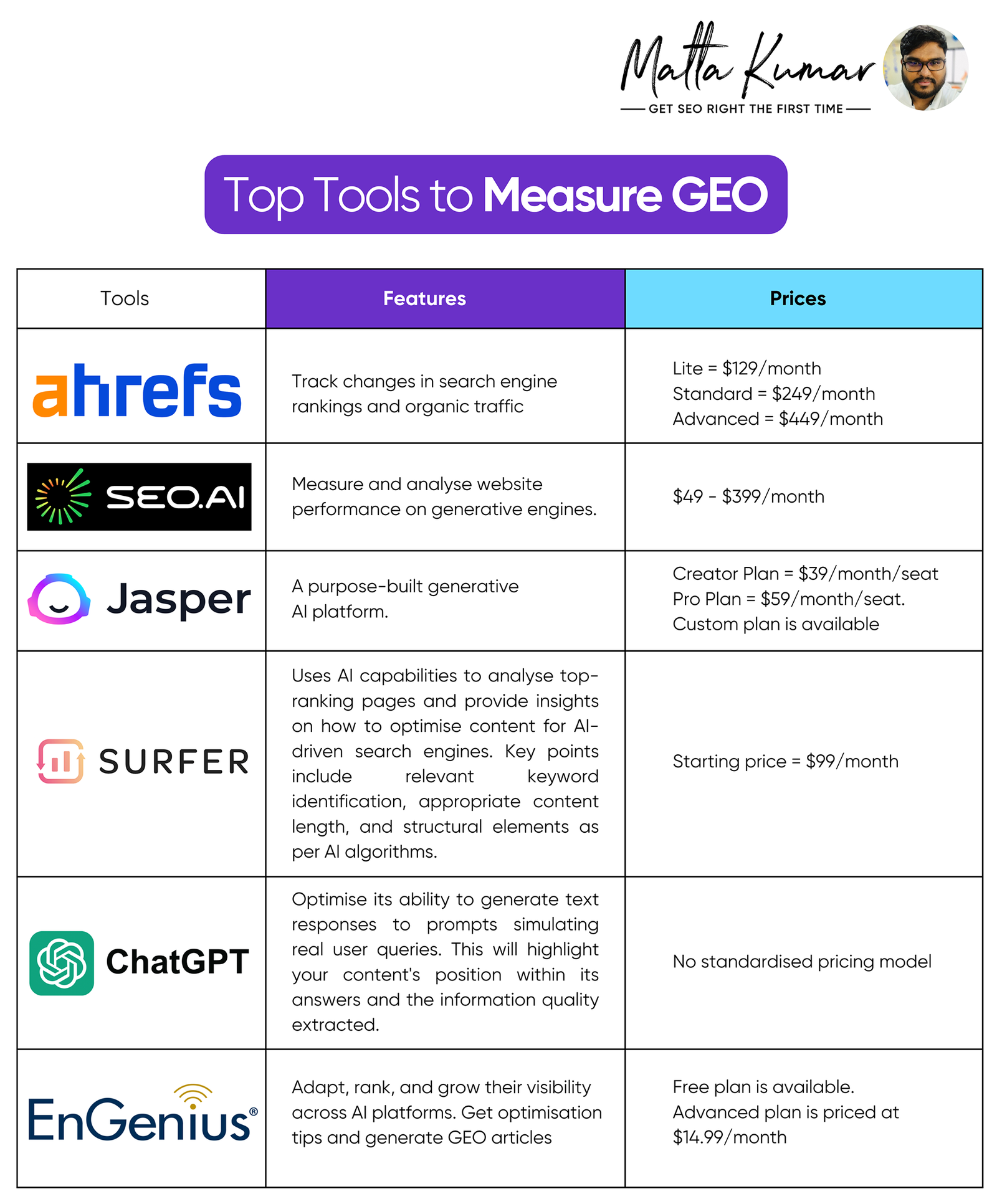SEO vs GEO: Which is Best for Search Optimisation in the Gen AI Era?
Share Post
Table of Contents
AI-generated searches are ballooning, and millions of people in the US alone are already rolling with the flow. In 2023, approximately 13 million adults in the United States claimed to have used generative artificial intelligence as a primary tool for online searches. The The same report suggested that by the end of 2027, generative engines will likely rise like a beacon for over 90 million online users. This is just a fraction of the user market. It goes without saying that the online search market is the most affected segment courtesy of Large Language Models (LLMs) and generative models. ChatGPT, Perplexity AI, and Google AI Search take full credit for popularising generative engines among users. Generative engine optimisation (GEO), therefore, has become a vital organ for companies and digital marketers. GEO is the go-to option for better digital content visibility because generative engines extract data directly from web content, with sources added, to deliver more intent-centric responses to user queries. That said, the paradigm shift is not restricted to generative engine optimisation only. The following paragraph will introduce the evolution of searches from organic to generative.
Search Engine Optimisation
Search Experience Optimisation
Generative Engine Optimisation
Search Generative Experience
Answer Engine Optimisation
Voice Engine Optimisation
Google’s AI overviews are primarily generative artificial intelligence summaries appearing on Google search results. The screenshot shows links to sources supporting the information displayed, enabling users to explore the topic further. The rising adoption of AI overviews means the time for traditional SEO is up, or so many fear. After all, how users find information online and how websites rank post AI overviews have since changed dramatically. Subsequently, reduced click-throughs and altered website rankings are expected because users find their information in the AI Overviews without having to click through to a website featuring more relevant, contextual, and user-intent-based content. Also, the fact that AI overviews are generative responses means that the demand for generative engine optimisation automatically takes the upper hand for businesses compared to SEO.
That said, Google has redefined the definition for clicks, impressions, and positions, as displayed in the screenshot below:
Aside from rankings, clicks, and impressions, Google’s AI overview is also likely to bring down organic search traffic for websites primarily targeting informational queries, such as ‘How do I change my tires?’. Your marketing strategies need to be more diversified, especially in paid promotional segments. Additionally, brands should prioritise website authority, brand reputation, and thought-leadership content and control their business information to survive and sustain the change.
In the words of authors David Edelman and Mark Abraham (Customer Experience in the Age of AI” in Harvard Business Review), “…competitive advantage will be based on the ability to capture, analyse, and utilise personalised customer data at scale and on how a company uses AI to understand, shape, customise, and optimise the customer journey. “
Introducing GEO - A New Approach to Internet Searches
Increased Reach
Improved User Experience
Competitive Advantage
Brand Authority
Enhanced SEO Strategy
Is GEO the Endgame for SEO - Understanding Why SEO is Losing its Trust
Do Companies Struggle to Adopt GEO Best Practices?
How does GEO Work?
The Core Principles of Generative Engine Optimisation
Understand Search Intent
Meet Google’s E-E-A-T Standards
Conversational Language
Direct Answers and Actionable Advice
Long-Tail Keyword Targeting
Data-Driven & Structured Content
Source Citation
Contextual Relevance
Content Quality and Authority
Strategies for Effective Generative Engine Optimisation
Focus on User Intent
Use Conversational and Natural Language
Provide Clear and Direct Answers
Optimise for Long-Tail Keywords
Structure Content for AI Readability
Ensure Contextual Depth and Relevance
Cite Authoritative Sources
How to Measure GEO
- 1. AI Search Visibility – Check the frequency of your content featured in answer boxes and summaries.
- 2. User Engagement Metrics – Clicks, time on page, and interaction rates help gauge audience interest and content relevance.
- 3. Query Relevance — Assess whether your content aligns with AI-generated queries. Search intent match rates can give you a fair idea.
- 4. Traffic Sources – If AI-driven platforms drive organic traffic to your website, you should start optimising them accordingly.
- 5. Content Performance – Impressions, rankings, and conversion rates help measure GEO’s overall impact on discoverability.
Points to Consider When Measuring GEO with Tools
- 1. User Intent Understanding – Evaluate content as per user queries, beyond just matching keywords.
- 2. Conversational Tone – Keep your tone natural and engaging to sound like regular human interaction.
- 3. Structured Data Implementation – Schema markup can help AI understand and categorise your content accurately.
- 4. Citation and Source Credibility – Know the frequency of your content, citing authoritative sources to enhance trust.
- 5. Depth of Information —Does your content provide comprehensive insights, or is it curated on surface-level details? Make sure of this.
- 6. AI-Friendly Keyword Usage – Analyse if your content includes natural, conversational phrases users commonly search for.
- 7. Visibility in Generative Responses – Monitor the frequency of your content's appearance in AI-generated summaries and answers.
- 8. Content Diversity – Use varied formats like lists, tables, and multimedia to cater to user preferences.
- 9. Brand Consistency – Verify that AI-generated responses align with your brand voice and messaging.
- 10. AI-Powered Analytics Tools – Leverage tools to assess conversational tone, relevance, and structured data usage.
- 11. Citation Tracking Tools – Measure how often your content comes up as a reference in AI-generated content across platforms.
- 12. Generative AI Analytics – Keep your strategy refined by checking performance insights from AI-driven search engines.
- 13. AI-Focused Keyword Research – Identify long-tail keywords to align with conversational search patterns closely.
Final Tip: Since AI search engines evolve rapidly, continuously track and adjust your content strategy to stay ahead.
How to Build Content for Both SEO and GEO
- 1. Understand User Intent – Your content should satisfy keyword-based searches (SEO) and AI-driven queries (GEO).
- 2. Use Conversational Language – A natural and conversational tone elevates readability for human users and AI-generated responses.
- 3. Optimise for Long-Tail Keywords – Specific, intent-driven queries are targeted for better search rankings and AI visibility.
- 4. Provide Direct and Structured Answers — Sound formatting with clear headings, bullet points, and summaries is the best tip for easy AI parsing.
- 5. Leverage Structured Data – Schema markup implementation helps AI to understand and categorise content more effectively.
- 6. Cite Authoritative Sources — Refer to credible sources to build searchers' trust. Additionally, such citations improve AI-generated citation potential.
- 7. Ensure Content Depth and Relevance — Cover topics comprehensively. This will enhance both organic rankings and AI-driven engagement.0
- 8. Monitor Performance Metrics – Track traditional SEO analytics (traffic, rankings) and GEO-specific insights (AI citations, query matches).


















